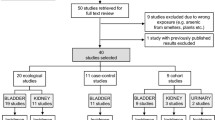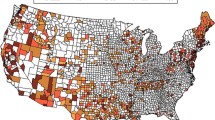Abstract
Objective
Arsenic in drinking water has been linked with the risk of urinary bladder cancer, but the dose–response relationships for arsenic exposures below 100 μg/L remain equivocal. We conducted a population-based case–control study in southeastern Michigan, USA, where approximately 230,000 people were exposed to arsenic concentrations between 10 and 100 μg/L.
Methods
This study included 411 bladder cancer cases diagnosed between 2000 and 2004, and 566 controls recruited during the same period. Individual lifetime exposure profiles were reconstructed, and residential water source histories, water consumption practices, and water arsenic measurements or modeled estimates were determined at all residences. Arsenic exposure was estimated for 99% of participants’ person-years.
Results
Overall, an increase in bladder cancer risk was not found for time-weighted average lifetime arsenic exposure >10 μg/L when compared with a reference group exposed to <1 μg/L (odds ratio (OR) = 1.10; 95% confidence interval (CI): 0.65, 1.86). Among ever-smokers, risks from arsenic exposure >10 μg/L were similarly not elevated when compared to the reference group (OR = 0.94; 95% CI: 0.50, 1.78).
Conclusions
We did not find persuasive evidence of an association between low-level arsenic exposure and bladder cancer. Selecting the appropriate exposure metric needs to be thoughtfully considered when investigating risk from low-level arsenic exposure.


Similar content being viewed by others
References
National Research Council (2001) Arsenic in Drinking Water: 2001 Update. National Academy of Sciences Press, Washington
Smedley PL, Kinniburgh DG (2002) A review of the source, behavior and distribution of arsenic in natural waters. Appl Geochem 17:517–568
Parkin DM, Bray F, Ferlay J, Pisani P (2005) Global cancer statistics, 2002. CA Cancer J Clin 55:74–108
Silverman DT, Devesa SS, Moore LE, Rothman N (2006) Bladder Cancer. In: Schottenfeld D, Fraumeni J (eds) Cancer epidemiology and prevention, 3rd edn. Oxford University Press, New York, pp 1101–1127
International Agency for Research on Cancer (2002) IARC monographs on the evaluation of carcinogenic risks to humans: some drinking-water disinfectants and contaminants, including arsenic, vol 84. International Agency for Research on Cancer, Lyon
Sams R II, Wolf DC, Ramasamy S, Ohanian E, Chen J, Lowit A (2007) Workshop overview: arsenic research and risk assessment. Toxicol Appl Pharmacol 222:245–251
Schoen A, Beck B, Sharma R, Dube E (2004) Arsenic toxicity at low doses: epidemiological and mode of action considerations. Toxicol Appl Pharmacol 198:253–267
Chen YC, Su HJJ, Guo YLL et al (2003) Arsenic methylation and bladder cancer risk in Taiwan. Cancer Causes Control 14:303–310
Cuzick J, Sasieni P, Evans S (1992) Ingested arsenic, keratoses, and bladder cancer. Am J Epidemiol 136:417–421
Hopenhayn-Rich C, Biggs ML, Fuchs A et al (1996) Bladder cancer mortality associated with arsenic in drinking water in Argentina. Epidemiology 7:117–124
Tsuda T, Babazono A, Yamamoto E et al (1995) Ingested arsenic and internal cancer: a historical cohort study followed for 33 years. Am J Epidemiol 141:198–209
Baastrup R, Sorensen M, Balstrom T et al (2008) Arsenic in drinking-water and risk for cancer in Denmark. Environ Health Perspect 116:231–237
Bates MN, Smith AH, Cantor KP (1995) Case-control study of bladder cancer and arsenic in drinking water. Am J Epidemiol 141:523–530
Bates MN, Rey OA, Biggs ML et al (2004) Case-control study of bladder cancer and exposure to arsenic in drinking water in Argentina. Am J Epidemiol 159:381–389
Karagas MR, Tosteson TD, Morris JS et al (2004) Incidence of transitional cell carcinoma of the bladder and arsenic exposure in New Hampshire. Cancer Causes Control 15:465–472
Kurttio P, Pukkala E, Kahelin H, Auvinen A, Pekkanen J (1999) Arsenic concentrations in well water and risk of bladder and kidney cancer in Finland. Environ Health Perspect 107:705–710
Lamm SH, Engel A, Kruse MB et al (2005) Arsenic in drinking water and bladder cancer mortality in the United States: An analysis based on 133 U.S. counties and 30 years of observation. J Occup Environ Med 46:298–306
Lewis DR, Southwick JW, Ouellet-Hellstrom R, Recnh J, Calderon RL (1999) Drinking water arsenic in Utah: a cohort mortality study. Environ Health Perspect 107:359–365
Michaud DS, Wright ME, Cantor KP, Taylor PR, Virtamo J, Albanes D (2004) Arsenic concentrations in prediagnostic toenails and the risk of bladder cancer in a cohort study of male smokers. Am J Epidemiol 160:853–859
Steinmaus C, Yuan Y, Bates MN, Smith AH (2003) Case-control study of bladder cancer and drinking water arsenic in the western United States. Am J Epidemiol 158:1193–1201
Cantor KP (2001) Invited commentary: Arsenic and cancer of the urinary tract. Am J Epidemiol 153:419–421
Cantor KP, Lubin JH (2007) Arsenic, internal cancers, and issues in inference from studies of low- level exposures in human populations. Toxicol Appl Pharmacol 222:252–257
Devesa SS, Grauman DG, Blot WJ, Pennello G, Hoover RN, Fraumeni JF Jr (1999) Atlas of cancer mortality in the United States, 1950–94. NIH Publication No. 99–4564. National Cancer Institute, Washington
Michigan Department of Public Health (1982) Arsenic in drinking water–a study of exposure and clinical survey. Lansing, MI: Division of Environmental Epidemiology, Michigan Department of Public Health
Kolker A, Haack SK, Cannon WF (2003) Arsenic in southeastern Michigan. In: Welch AH, Stollenwerk KG et al (eds) Arsenic in ground water. Kluwer, Norwell, pp 281–294
Frost FJ, Muller T, Petersen HV, Thomson B, Tollestrup K (2003) Identifying US populations for the study of health effects related to drinking water arsenic. J Expo Sci Environ Epidemiol 13:231–239
Meliker JR, Slotnick MJ, AvRuskin GA et al (2007) Individual lifetime exposure to inorganic arsenic using a Space-Time Information System. Int Arch Occup Environ Health 80:184–197
Meliker JR, Franzblau A, Slotnick MJ, Nriagu JO (2006) Major contributors to inorganic arsenic intake in Southeastern Michigan. Int J Hyg Environ Health 209:399–411
Slotnick MJ, Meliker JR, Nriagu JO (2006) Effects of time and point-of-use devices on arsenic levels in Southeastern Michigan drinking water, USA. Sci Total Environ 369:42–50
Goovaerts P, AvRuskin G, Meliker J, Slotnick M, Jacquez G, Nriagu J (2005) Geostatistical modeling of the spatial variability of arsenic in groundwater of southeast Michigan. Water Resources Res 41:W07013
Meliker JR, AvRuskin GA, Slotnick MJ et al (2008) Validity of spatial models of arsenic concentrations in private well water. Environ Res 106:42–50
Natural Resources Defense Council (2000) Arsenic and old laws: a scientific and public health analysis of arsenic occurrence in drinking water, its health effects, and EPA’s outdated arsenic tap water standard. http://www.nrdc.org/water/drinking/arsenic/aolinx.asp. Accessed 20 Sept 2005
USGS (2000) Arsenic in Groundwater of the United States. Data updated March 30, 2000. http://water.usgs.gov/nawqa/trace/arsenic/. Accessed 20 Sept 2005
Cheng Z, Van Geen A, Seddique AA, Ahmed KM (2005) Limited temporal variability of arsenic concentrations in 20 wells monitored for 3 years in Araihazar, Bangladesh. Environ Sci Technol 39:4759–4766
Steinmaus CM, Yuan Y, Smith AH (2005) The temporal stability of arsenic concentrations in well water in western Nevada. Environ Res 99:164–168
Rothman N (1981) Induction and latent periods. Am J Epidemiol 114:253–259
Kobrosly RW, Meliker JR, Nriagu JO (2009) Automobile industry occupations and bladder cancer: a population-based case-control study in southeastern Michigan, USA. Occup Environ Med 66:650–656
Bureau of the Census (2000) Alphabetical index of industries and occupations. Bureau of the Census, Washington
Wright JM, Murphy PA, Nieuwenhuijsen MJ, Savitz DA (2006) The impact of water consumption, point-of-use filtration and exposure categorization on exposure misclassification of ingested drinking water contaminants. Sci Total Environ 366:65–73
Shimokura GH, Savitz DA, Symanski E (1998) Assessment of water use for estimating exposure to tap water contaminants. Environ Health Perspect 106:55–59
Moore LE, Smith AH, Eng C et al (2003) P53 alterations in bladder tumors from arsenic and tobacco exposed patients. Carcinogenesis 24:1785–1791
Chen CH, Chiou HY, Hsueh YM, Chen CJ, Yu HJ, Pu YS (2009) Clinicopathologic characteristics and survival outcome of arsenic related bladder cancer in Taiwan. J Urol 181:547–553
Puente D, Hartge P, Greiser E et al (2006) A pooled analysis of bladder cancer case-control studies evaluating smoking in men and women. Cancer Causes Control 17:71–79
Kantor AF, Hartge PF, Hoover RN, Fraumeni JF Jr (1985) Familial and environmental interactions in bladder cancer risk. Int J Cancer 35:703–706
Richardson DB, Wing S (1998) Methods for investigating age differences in the effects of prolonged exposures. Am J Ind Med 33:123–130
Boffetta P, McLaughlin JK, La Vecchia C, Tarone RE, Lipworth L, Blot WJ (2008) False-positive results in cancer epidemiology: a plea for epistemological modesty. J Natl Cancer Inst 100:988–995
Acknowledgments
We extend deep appreciation to study participants for taking part in this research. We also thank Joe Lovato, Sheridan Haack, Stacey Fedewa, Angela Hungerink, Roni Kobrosly, Zorimar Rivera-Núñez, Aaron Linder, Nicholas Mank, Caitlyn Meservey, Erin Zazzera, and Taylor Builee for valuable assistance with different aspects of this project. This research was funded by the National Cancer Institute, Grant R01 CA96002-10. The perspectives are those of the authors and do not necessarily represent the official position of the funding agency.
Author information
Authors and Affiliations
Corresponding author
Rights and permissions
About this article
Cite this article
Meliker, J.R., Slotnick, M.J., AvRuskin, G.A. et al. Lifetime exposure to arsenic in drinking water and bladder cancer: a population-based case–control study in Michigan, USA. Cancer Causes Control 21, 745–757 (2010). https://doi.org/10.1007/s10552-010-9503-z
Received:
Accepted:
Published:
Issue Date:
DOI: https://doi.org/10.1007/s10552-010-9503-z




